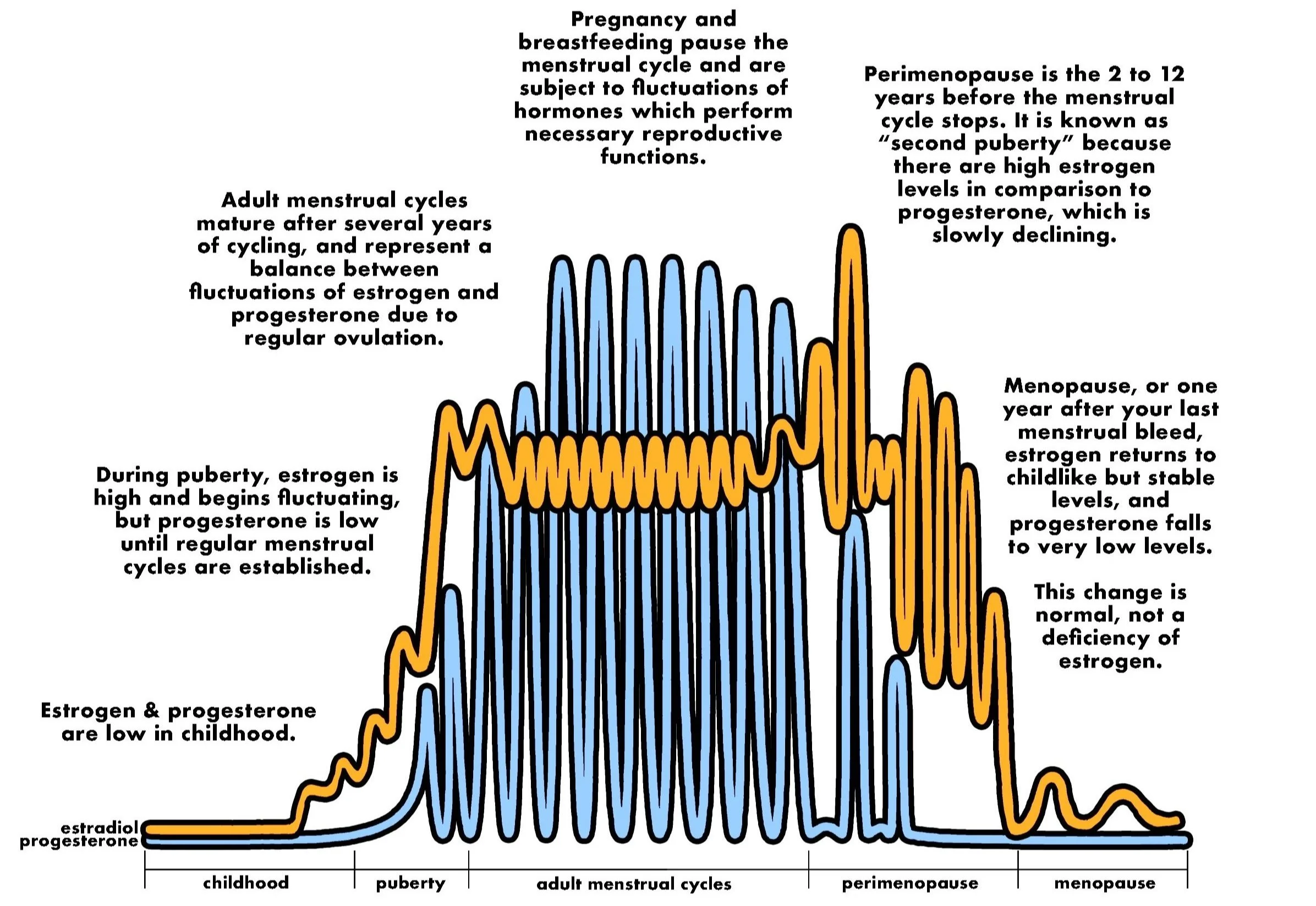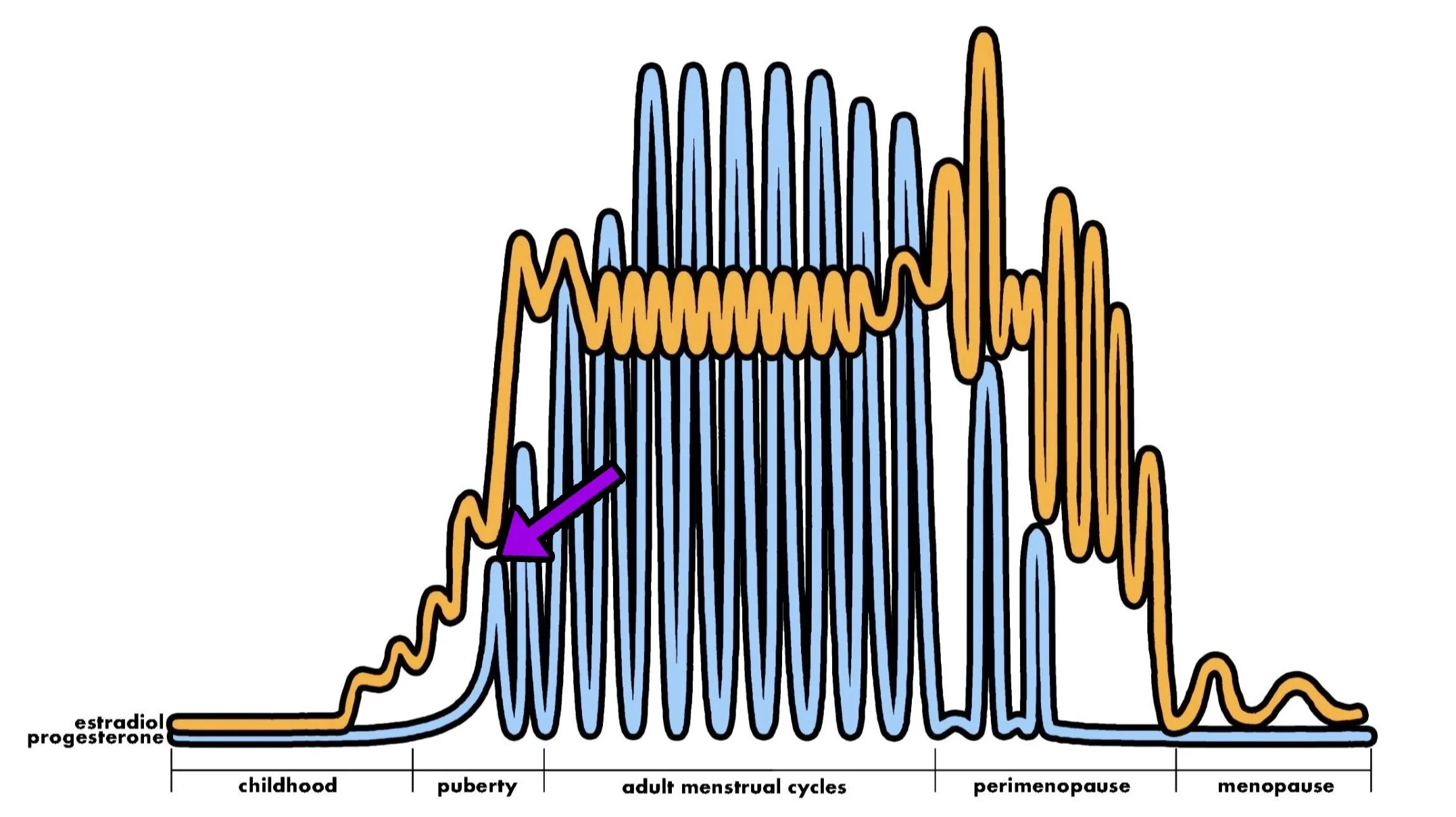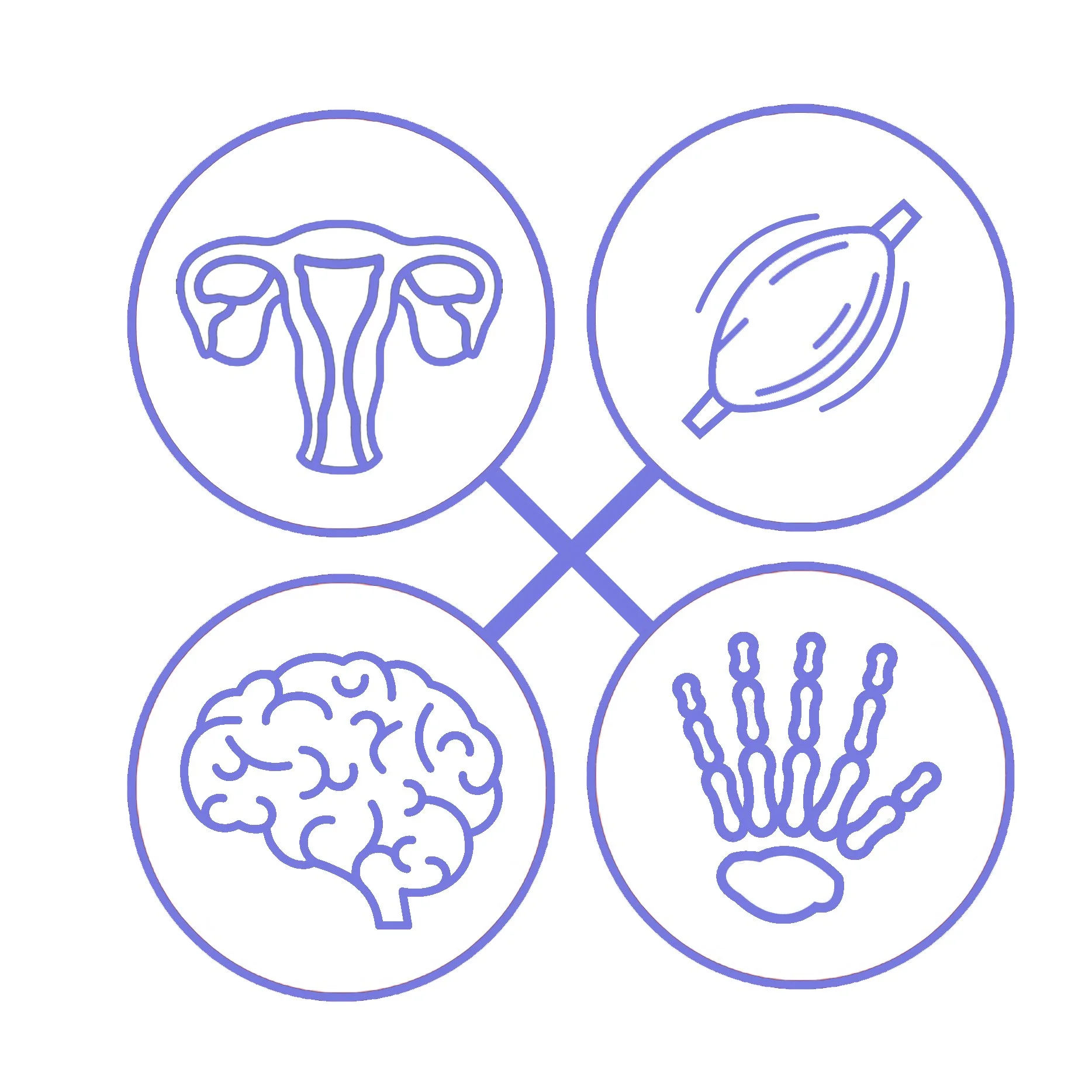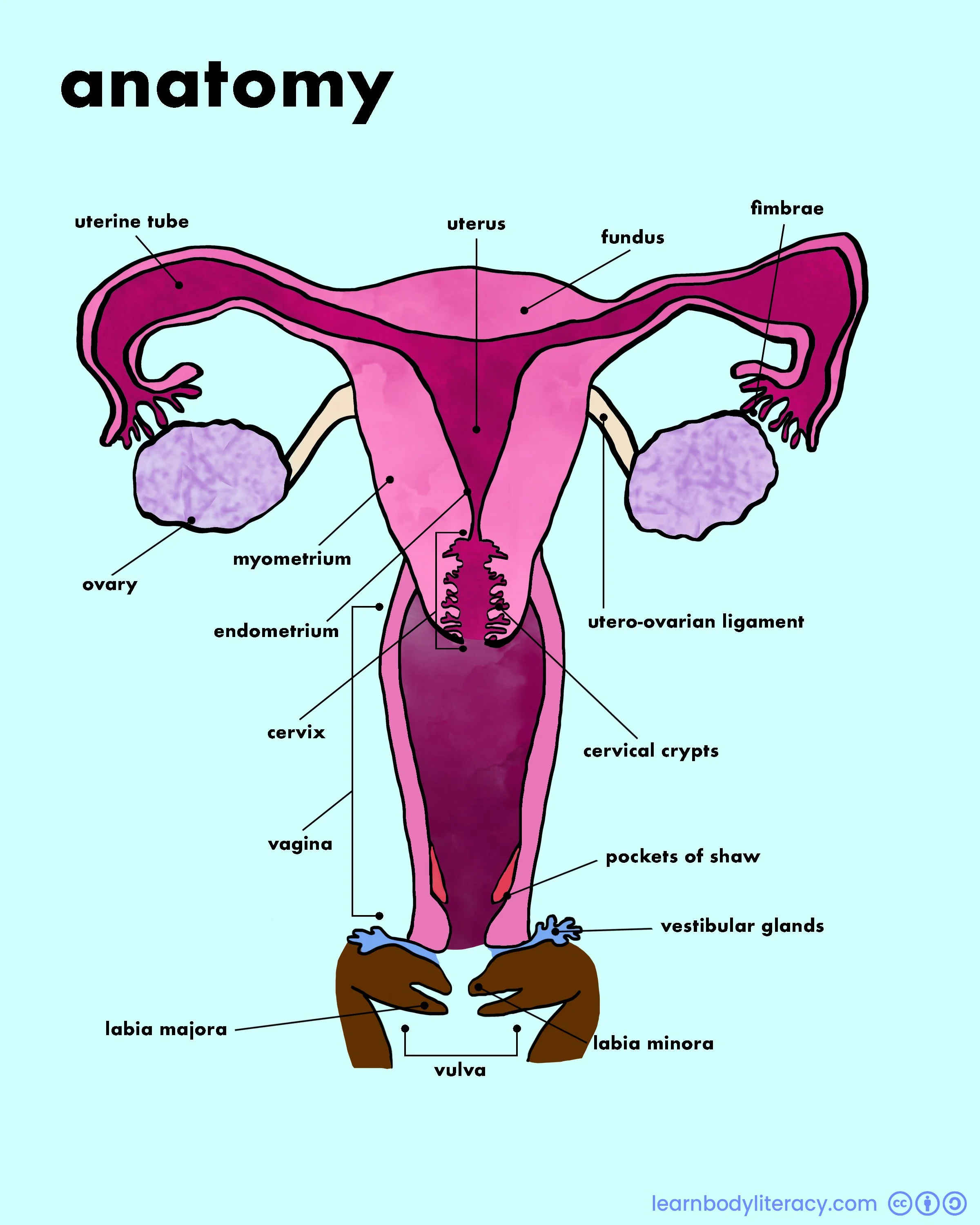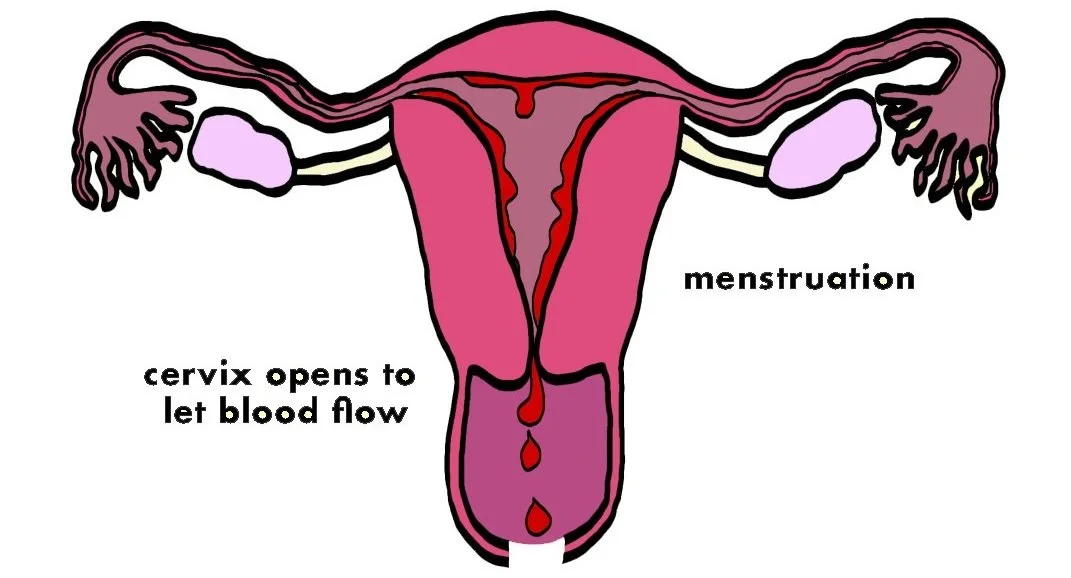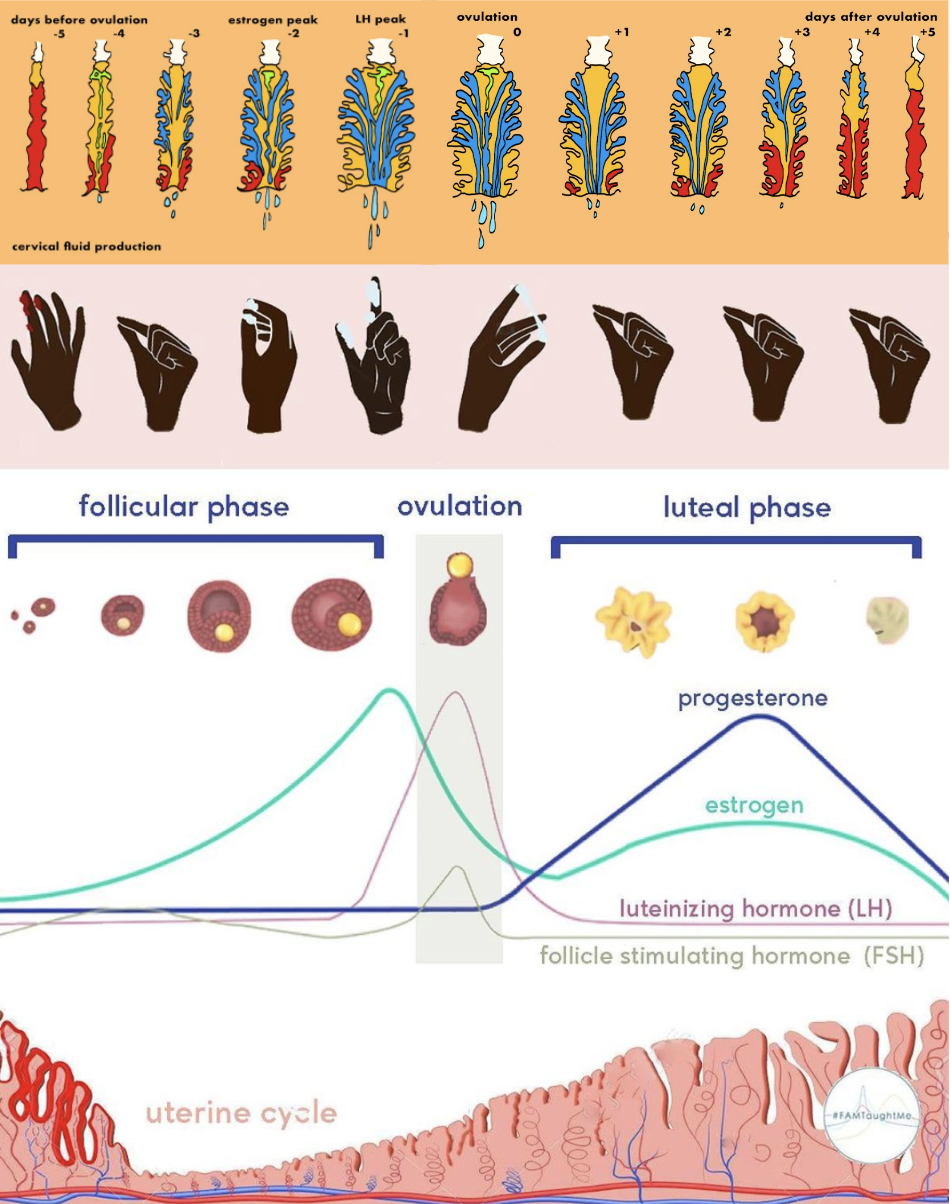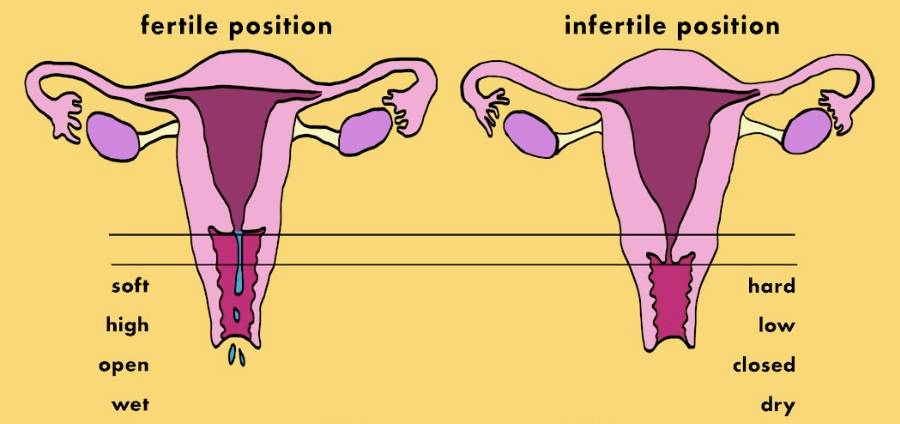Welcome to Menarche.
Menarche is the first menstrual cycle, or first menstrual bleeding in your lifetime.
The Menstrual Life Cycle
A series of hormonal changes that shift during different stages in life in the context of your ovarian hormones
For Tweens and Teens
Knowledge can encourage empowerment.
Let’s go over some of the changes you might expect.
Before you get your first menstruation, estrogen begins to fluctuate.
Fluctuating estrogen causes changes to your body. You may notice changes to your nipples, chest, and pubic hair.
1-3 years after this, your first menstruation will arrive and your body will make progesterone.
Menstruation is the normal and cyclical shedding of your uterine lining. It signifies that your body will start developing for the next few years into an adult body, that you begin ovulating and making ovarian hormones, and that you are able to become pregnant.
These hormones are important, not only for reproduction, but to help you build strong muscles and bones, a healthy brain, and for regulating many parts of your health.
Puberty usually begins around age 8-10 but sometimes begins earlier.
Breasts
Nipples develop first, with the small bumps around the nipple becoming raised. The darker area around the nipple grows larger and the breast starts to develop outwards. This is called breast buds and may not happen at the exact same time on each breast. It could be 1-3 years before you get your first period after developing breast buds, depending on your age.
Pubic Hair
Around the time your breasts begin developing, hairs will fill in around your genital area and groin. They may start out as just a few hairs and continue to grow in thicker over time. Your underarm hair may take awhile longer to grow in after menstruation begins.
Rapid Body Growth
The body will begin to grow faster during puberty and around the time that menstruation begins. This is slightly different for each person, and your biggest growth spurt may become before or after the first menstruation. Your hips will also widen and your body shape may develop, causing normal changes to your height and weight.
Reproductive Development
The interior reproductive system, the vagina, uterus, and ovaries, develop more during this time. The ovaries begin to ovulate, although they may not be regular at first. The exterior vulva lips (labia majora) will become thicker, and the inner lips (labia minora) will grow larger and become more textured and wrinkly. The clitoris grows in size too. For a closer look at anatomy, please visit the anatomy page.
Cervical Fluid / Vaginal Cell Slough
Fluctuating estrogen tells your cervix to start producing a white or clear fluid. This may show up on your underwear, or be noticeable when you wipe yourself or walk around. Cervical fluid will appear shortly before the arrival of first menstruation. The walls of the vagina also produce a small amount of liquid which helps the vagina regulate its own healthy bacteria and protects the body from harm. Fluid changes day to day, and will become one of the three main fertility signs. Visit the menstrual years section for more info.
Other Changes
Skin may become more oily, causing acne, but this is a normal part of puberty that will subside after puberty. Your underarms may emit a stronger smell. Underarm
FAQ’s for Menarche
-
Menarche, or first menstruation, is a sign you have reached the beginning of your menstruating years, and it becomes possible to get pregnant. The first 24 cycles tend to be unpredictable, as the body develops its hormonal rhythm. Menses may not come at the same time each month, they may not last the same amount of time, and the amount of blood lost can fluctuate too. After this, the cycle should become more regular, but even adult menstrual cycles vary.
-
When you first begin menstruating it’s normal to have:
Cycles that last between 21 and 45 days, but may sometimes be longer or shorter
Menstruations lasting seven days or less
Blood loss of about 5-30mL, remember that absorbent products will make it hard to calculate but expect to use 3-5 disposable menstrual products per day.
After the first couple years of menstruating, cycles should normalize into the 24–38 day range.
Some minor discomfort in the abdominal area
-
The ovarian hormones are just getting started during puberty. They may fluctuate as they learn how to regulate themselves before coming into a rhythm.
Ovulation is the main event of each menstrual cycle, but ovulation may only happen a couple times in the first year of experiencing menstruations. After 6 years, this happens in about 9 in 10 cycles, much more regularly.
The longer it takes to ovulate, the longer it takes to menstruate, so this may cause your menstruations to appear irregular. Remember, this is normal in your early menstrual years. These fluctuating hormones may also cause physical and psychological changes.
-
It can take 6-12 years for the menstrual cycle to mature. Your reproductive hormones are still coming into balance during puberty.
In the years after you start menstruating, your hormones are not yet regular enough to cause ovulation to happen each cycle. Ovulation only happens in about 2 in 10 cycles during the first year of having your cycle. By the sixth year, ovulation happens in about 9 in 10 cycles (1-3). When you don’t ovulate, your menses may come at a different time. It can look and feel differently too and your cycle symptoms will probably be different. Eventually, your hormones should come into balance. Your cycle is still likely to vary a bit after that, but not like when it first begins.
-
Yes, a menstrual cycle means that you are having an ovulatory cycle, and ovulation is when you release eggs.
Pregnancy is possible even if you haven’t had your first menstruation yet if you have unprotected intercourse while fertile. Ovulation and the uterine lining thickening both happen in the weeks leading up to menstruation. Safe, protected penis in vagina sex is important, whenever you choose to have it.
-
On average, it takes six to ten years for the menstrual cycle to normalize its rhythm.
-
Talk to a healthcare provider if you have:
Cycles that last longer than 45 days or shorter than 21 days
Menses that become very irregular after having regular cycles for at least 6 months
No menses by age 15
No menses for more than 90 days
Intense pain and menstrual cramps
Hair thinning on your head or excess hair growth in a male type pattern such as along the jawline and upper back
-
As a teen, you may wonder when you need to have a check-up with an OB/GYN. Only you and your parents or guardians will know when the right time is, or if it’s necessary at all.
An OB/GYN visit should only consist of some questions about the body and your health, and may ask the date of your first menstruation and how your cycles have been progressing.
You do not have to share your cycle information with a doctor if you don’t want to, and a pelvic exam should not be performed. Pelvic exams are performed later around when you reach the age of 21 unless there is a specific reason.
Your Red Flow
Here’s what to look for in a healthy menstruation:
Normalization of body functions: the body should go through the process of menstruation easily and smoothly. We call this homeostasis, or a tendency towards balance.
A typical menstruation lasts 3-7 days and should contain about 50 mL of blood - thats only around 3 tablespoons in total. A range between 30-80 mL is considered normal.
Hemodynamics: the dynamics of blood flow to be working smoothly and to not stagnate. Blood flow coming in brings oxygen, nutrients, and hormones and blood flow coming out discards waste, toxins, and assures new blood returns in its place.
Menstrual blood should be a bright red blood, with a liquid flow, and minimal clotting. Clots should be no larger than the size of a dime, because a healthy body produces natural anti-coagulants to thin the uterine lining and release it more easily.
Lastly, a healthy menstruation has no pain and no more than 30 minutes of discomfort. When your body is in a state of homeostasis and hemodynamics are working as intended, the body doesn’t have to work so hard to release blood, and thus there is no need for severe contractions that you see with cramping and other severe symptoms like nausea and vomiting.
Visit Read Your Bleed to learn what your menstrual blood says about your health
Every menstrual cycle, the body thickens the uterine lining to prepare for a potential fertilized egg.
If the egg doesn’t meet with a sperm, progesterone drops, and menstruation occurs.
Your White Flow
Just like menstruation comes in a pattern, your white flow of cervical fluid will also follow a pattern in the middle of your cycle. Cervical fluid is fluid that is made by the cervical glands in the cervix as the body responds to the hormone estrogen.
Fertile fluid will fall out of the body to the vulva, and observing it tells us when pregnancy is possible. We call it our #1 diagnostic fertility sign.
Cervical fluid can range in color
white
off-white
clear
pinkish
Texture can range from
dry
sticky or tacky
creamy or lotiony
watery or wet
and “egg-white” that stretches 1” between your fingers
Sensation at the vulva can range from
dry
moist
wet
slippery
Mainly you want to look for a fluid that keeps its shape when you pick it up, or that it stays separated when placed in a glass of water.
Learning to chart your cervical fluid can help you better understand when you are fertile, and when you ovulate each cycle.
Body Literacy Means to Read and Understand the Language of The Body
The menstrual cycle is considered a special additional vital sign.
Regular ovulations and regular, painless and healthy menstruations are a signal from the body that the body is working well. Using information from tracking your cycles regularly will help you identify if you need to seek help.
Getting Started With Charting Your Cycle
Menarche is an exciting time to be celebrated in life! This is the time to take charge of your cycles. Here’s how to do it:
Gather Your Tools - You’ll need to decide on a paper menstrual charting journal or a fertility awareness / menstrual tracking app. You may also want to acquire a basal body thermometer if you want to see yourself ovulate in your charts.
Chart The Basics - Start by tracking the dates of your menses. Remember that day 1 of the cycle is the first day of red menstrual blood flow. You can make notes about the color and consistency of your menstruation, and whether or not you experience pain or mood swings.
Learn Your Cervical Fluid Pattern - As you get more advanced in your charting, you can track when you observe cervical fluid. You can start by simply marking the days when you see fluid on toilet tissue, in your underwear, or feel it when walking around. Days where you don’t notice these signs can be marked as dry days. The vulva’s wetness fluctuates significantly between the fertile and infertile parts of the cycle.
Use Your Waking Body Temps To Predict Your Next Menstruation - After your temperature rises after ovulation, your menstruation will arrive ~2 weeks later. This can help you plan your month around resting to help nourish your cycle.
Add In Other Health Data - Over time you may want to track other health data, such as digestion, energy, mood, skin, headaches, and more.
Charting your cycle helps you learn what your unique “normal” looks like, and will help you identify when something is wrong or you are going through a period of stress.
For Parents/Guardians
Bringing empowerment, positivity, and awareness to first menses as a rite of passage.

We have the power to change the narrative about menstruation for our children.
For many years, teens and adults alike have been fed negative messaging around the menstrual life cycle.
Getting Started With Supporting Your Child Through Menarche
By framing the first menstrual cycle through the lens of positivity, empowerment, and awareness, we fight early enforced stigmas of embarrassment and shame.
Start With An Age Appropriate Foundation - This can begin in childhood by naming body parts correctly, teaching the anatomy of reproductive organs, how to care for their body, and eventually fielding questions they have about sex and relationships with honesty.
Teach Fertility Awareness as a Practice - Teens can find so much empowerment through understanding their menstrual cycle, but they won't learn at this crucial time if they aren't taught about it from a reliable, trustworthy source.
Tell Them They Can Come To You To Ask Questions - It is invaluable that you be available and open to talking positively about sexual health, fertility awareness, and body literacy. This means you have to start by educating yourself and practicing your own body literacy.
Learn The Benefits For Teens To Have A Menstrual Cycle - Because the cycle matures over several years, and the hormonal pattern develops during key years of puberty, you’ll want to familiarize yourself with the benefits of menstrual cycles for teen physical and mental health. Talk to your teens openly about different kinds of contraception and their potential risks vs benefits.
Use Resources to Explain Cervical Mucus and Normal Menses - Most of us never had knowledge that cervical fluid was healthy and normal. Most of us were never counseled about how menstruation could be healthy and painless. Teens should know they can understand their body, and take charge of their health through preventative measures. By developing these habits and rituals early, they set themselves up for easier and healthier menses during their adult years.
Go Over The Other Changes Besides Menstruation - Menstruation is about so much more than just bleeding. Helping your teen understand that they may feel different from week to week when they are cycling is a huge transition from their relatively stable hormones during their childhood years. Informing them of different ritualizing strategies to make menstruation easier and various menstrual products will help them feel empowered to take charge of their bodies.
Host A Period Party! (After asking) - Many cultures throughout the world have created ceremonies to honor this change. This might be a small gathering with family members who share stories and wisdom about their menstruation, having a gathering with friends to commemorate menstruation, or simply doing an exercise with your teen to journal about menses. They may not feel like partying, and just want to talk, and that’s ok too!
Purchase Resources To Help With The Transition - Below you can find charting journals and teen friendly books to help you talk about menstruation and sex education
Teen Friendly Books
<< Return to menopause
Next to menstrual years >>

